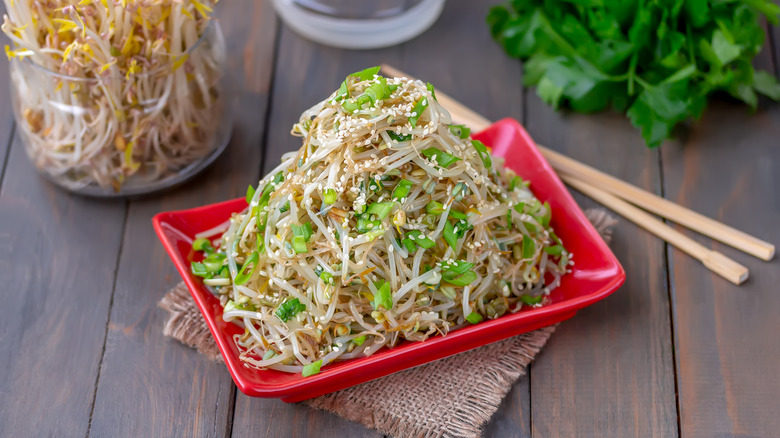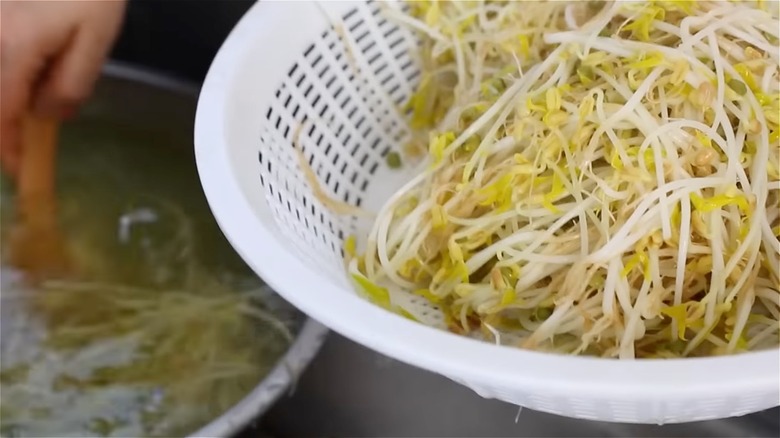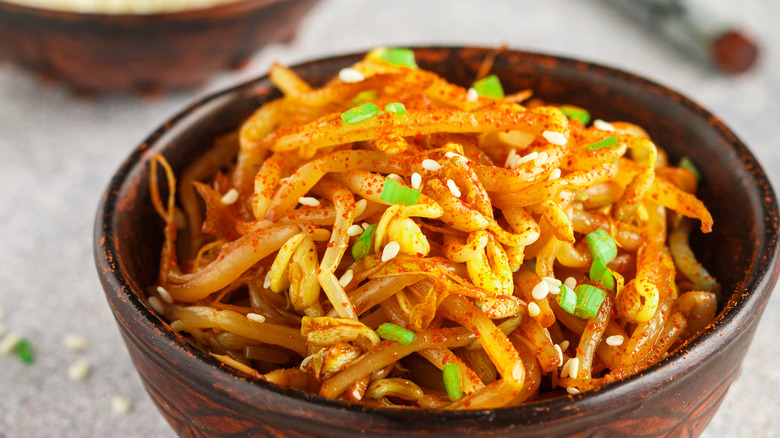The Blanching Tip You Need To Remember For Korean Bean Sprout Salad
Korean cuisine is not just a demonstration of culinary excellence but a sensory experience that stretches far beyond the mere plate. From the tantalizingly sweet and sour nature of kimchi to the juicy layers of vegetables, rice, and beef in a classic bibimbap. In Korean culinary tradition, emphasis is given to communal dining, underlining the importance of meals as a shared activity. Once mastered, a Korean bean sprout salad is a dish you'll be eager to share with everyone.
A Korean mung bean sprout salad (also named sukjunamul-muchim or sookju namul) is the epitome of balance. It's crunchy and tender, yet somehow soft, deliciously fresh, and utterly light. It's gently seasoned with the glorious flavors of nutty sesame, tangy garlic, umami soy sauce, and crisp sliced scallions. Yet what makes or breaks this salad is the texture of the bean sprouts.
The key is to blanch the bean sprouts in boiling water for 45 seconds to 2 minutes, then shock them in cold water. This allows the crisp natural body of the bean sprouts to relax and soften, yet not to the point that they are bendy and squidgy. A watchful eye is essential to ensure the bean sprouts have not missed this sensational equilibrium.
Sprout it up
Raw mung bean sprouts have a distinct, crunchy bite, which is undeniably satisfying. For this salad, though, the texture requires a slight softening. The exterior of the bean sprout is softened while the center remains intact; this allows the bean sprouts to keep their shape and be piled high for an unforgettable presentation.
Blanching the beans quickly achieves this texture; however, it is also important to rinse the bean sprouts in cold water immediately after removing them from the boiling water. Similar to how an ice bath works for vegetables and freezing their crispy nature, the rinsing of bean sprouts in cold water (also called "shocking" them) stops the sprouts from continuing to cook once they are removed.
Rinsing the bean sprouts also washes away skins or residue that may have fallen from the sprouts when they boiled. Strain well, or gently squeeze the residual liquid from the bean sprouts (not too tight; remember, texture is key), and it's ready to be dressed.
Other Korean salad tips
A Korean bean sprout salad would be pretty bland without its dressing, which typically includes toasted sesame oil and toasted sesame seeds. Toasting makes the flavor of the sesame much richer, more vibrant, and much more nutty than untoasted. Since the taste of bean sprouts is fairly mild, they serve as an excellent canvas for bolder flavors to play together in a dressing.
Soy sauce or fish sauce are other key components of the seasoning for this salad, injecting glorious umami savoriness while salting the salad in the process. Lastly, sliced scallions add a sharp tang and flecks of green that liven up the otherwise pale colors.
If you fancy a bean sprout side with a kick, then kongnamul-muchim (also known as kongnamool) is the perfect alternative for you. It has a similar dressing to the mung bean sprout salad mentioned above; however, it uses soy bean sprouts and incorporates gochugaru – a red Korean chili powder that packs a punch. The powder also adds a wonderful red tinge to the salad, a warning of the spice tucked away within.
If these Korean bean sprout dishes appeal to you, let's get that water boiling — either of them can be made in about 10 minutes.


